|
The Bay
St. Margaret's-at-Cliffe
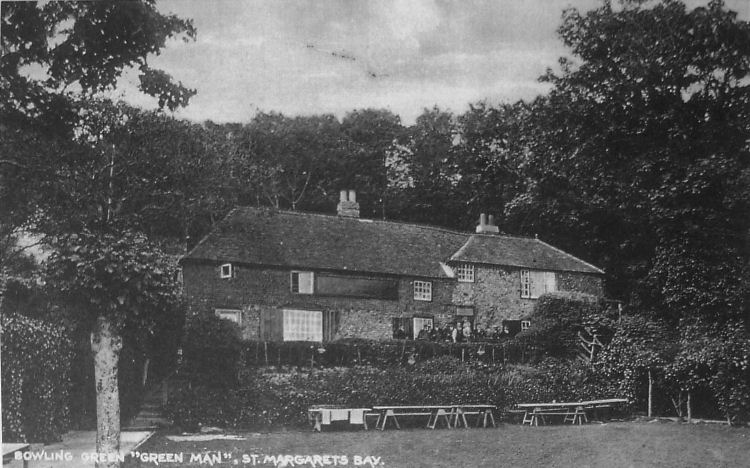 |
|
Above photo by permission of Coastguard says "Bowling Green, "Green
Man", St Margaret's Bay. |
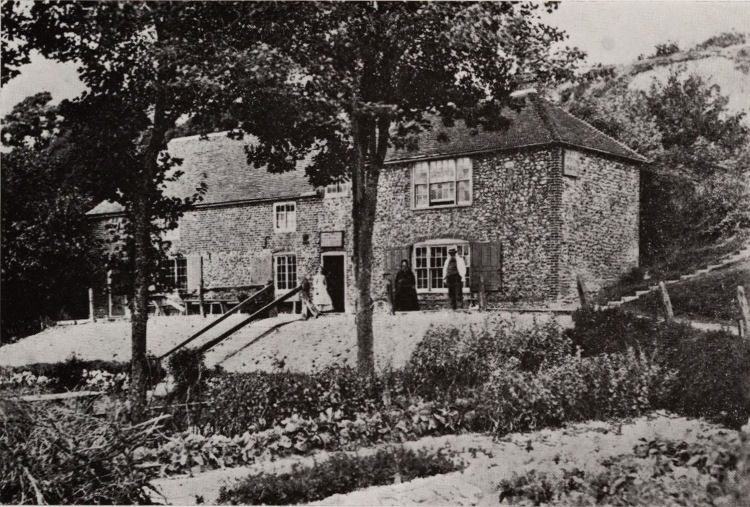 |
|
Green man circa 1900. The man standing in front of the window is
George Cramp landlord of the pub at the time. |
 |
|
Green man circa 1900. |
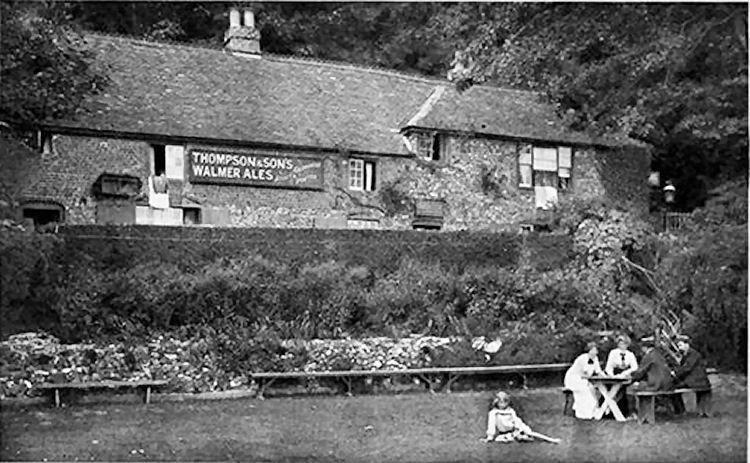
Above photo circa 1900. |
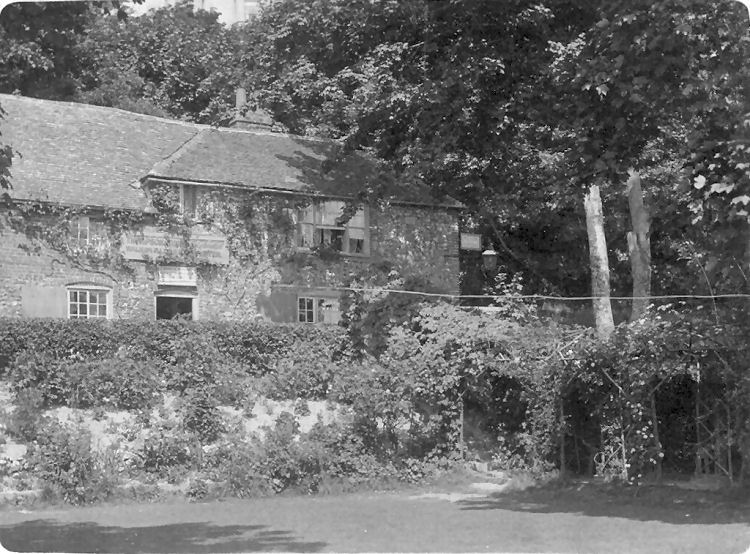
Above photo, July 1904. |
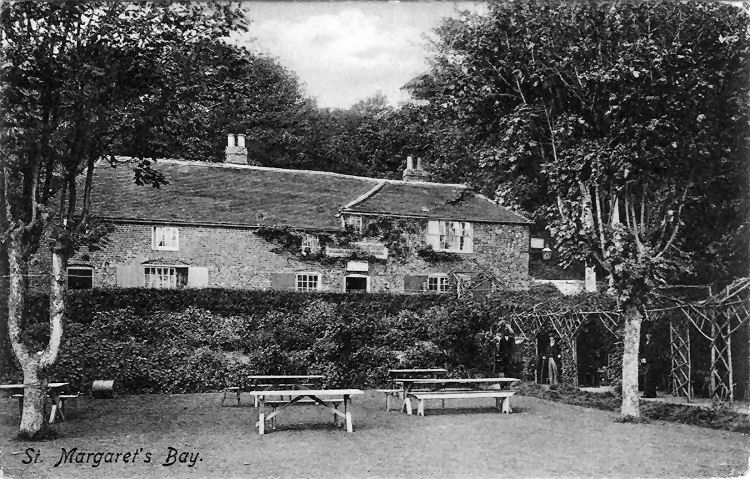 |
|
Above date unknown. |
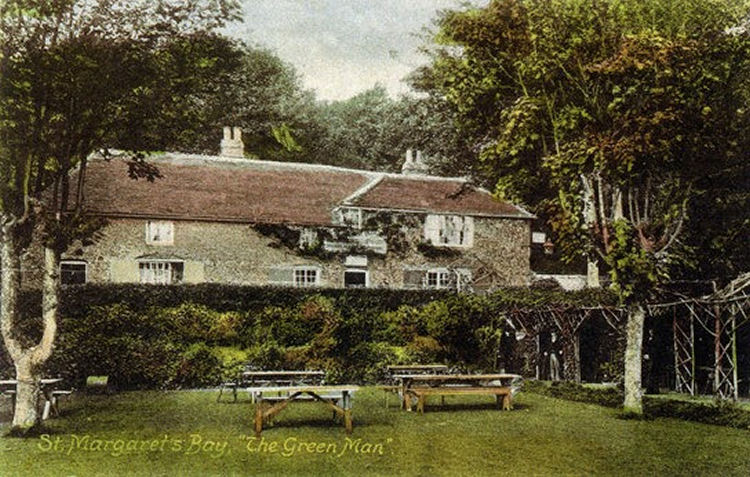
Above version is a coloured version of the one above this. |

Above postcard, date unknown. |

Above postcard, circa 1913, kindly sent by Rory Kehoe. |
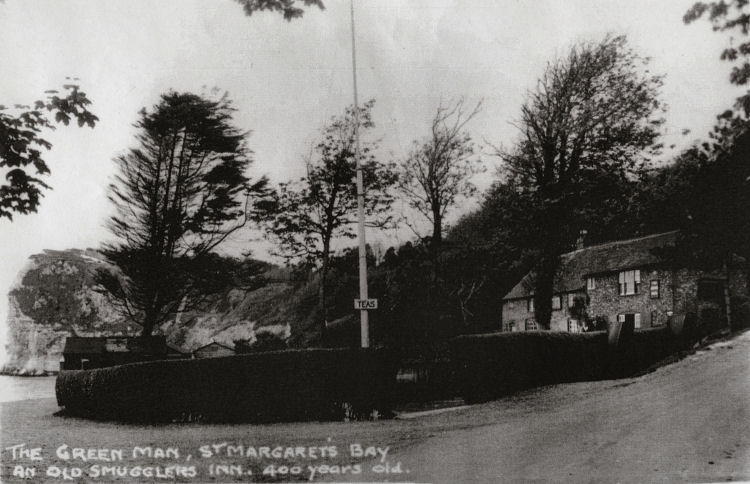
Notice the seats by the side of the road which are half boats upended. |
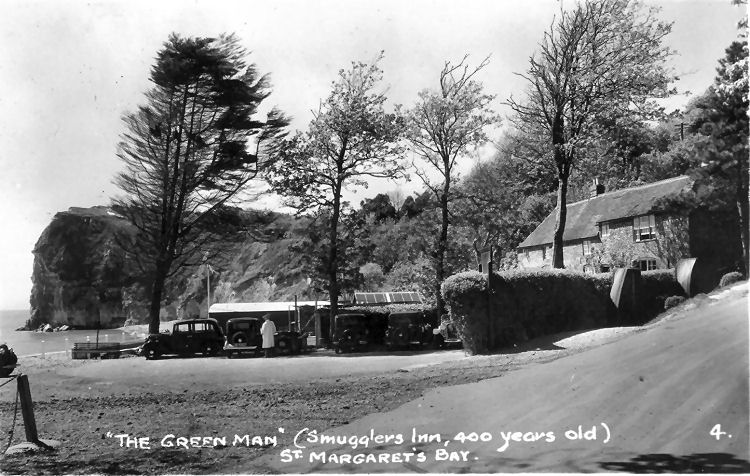
Above postcard circa 1930s. Kindly sent by Graham Butterworth. |
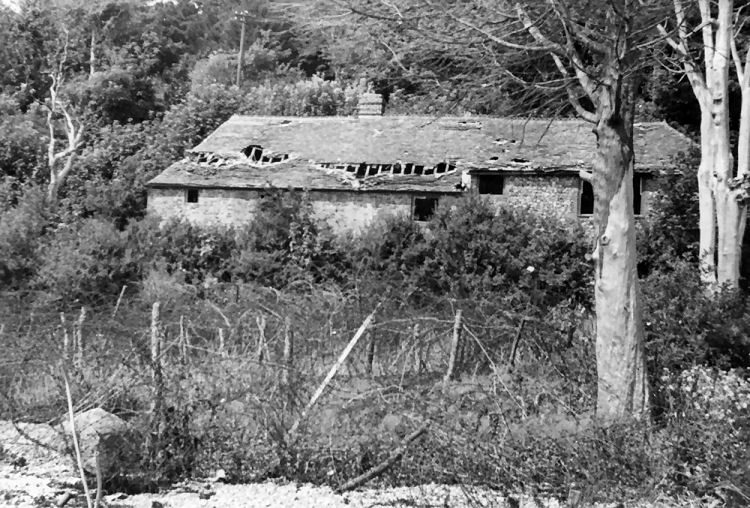
Above photo showing the war damage in 1945. |
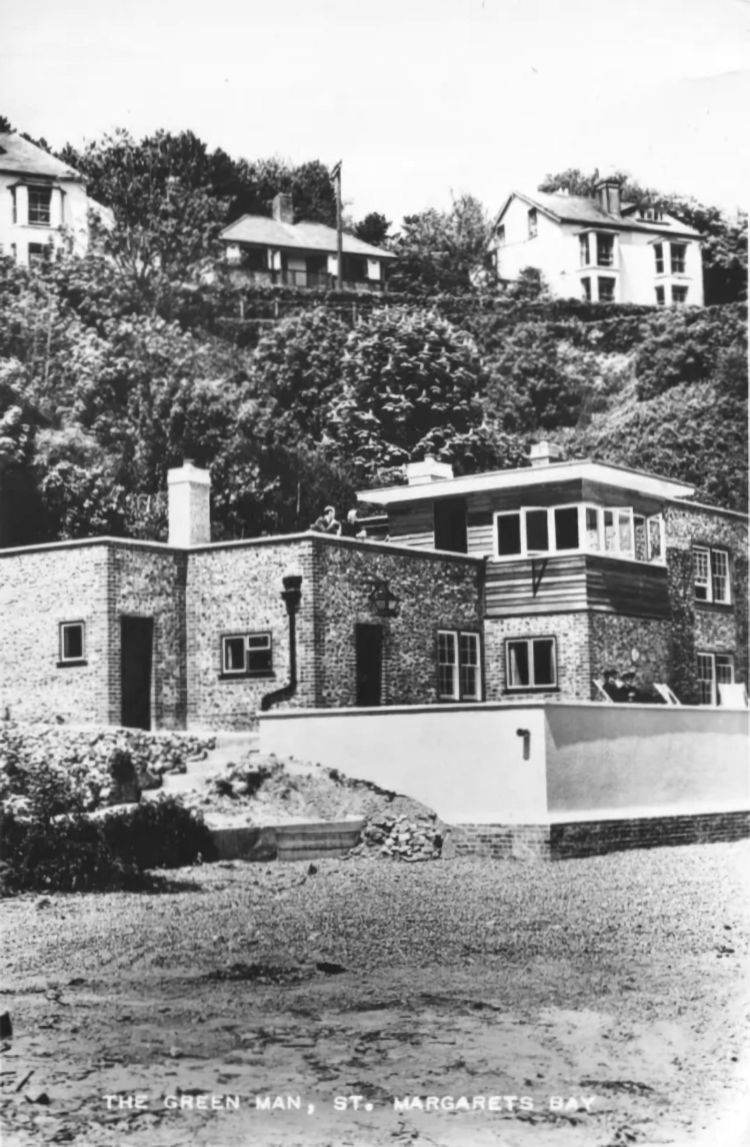
Above photo, 1956. Kindly sent by Rory Kehoe. Having been totally
destroyed during WW2 (by our own troops!) the pub lay derelict for
nearly 10 years. Before the war, it had been a tied house, within the
estate of Thompson's Walmer Brewery which, in 1951, was acquired by
Charrington's Anchor Brewery, London E1. One of Charrington's first
projects was to commission the rebuilding of the pub, which re-opened in
1954: the year after Charrington's closed down the Walmer brewery and
downgraded it to being merely a depot. |
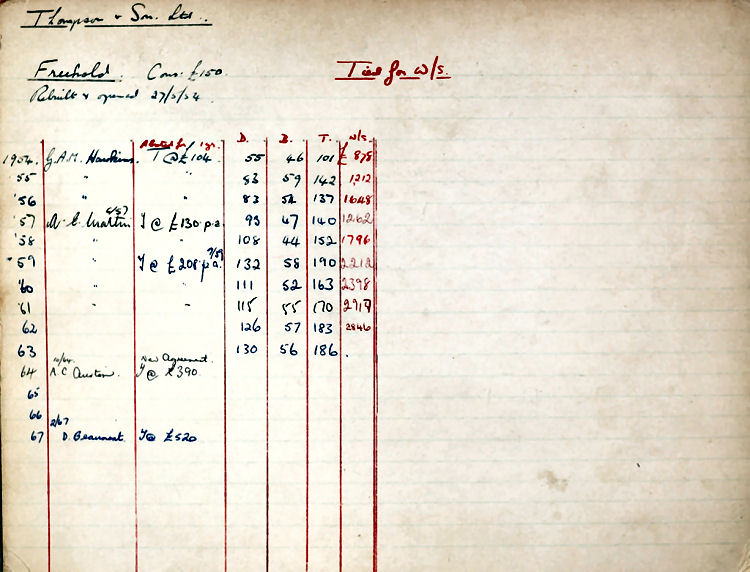
Thompson & Sons ledger.
Creative Commons Licence. |
Earliest reference found so far is in the Wingham Division Ale Licence list,
which shows the "Green Man," St Margaret's at Cliffe, although I am sure they
mean Bay, to be re-licensed for the sum of 8 shillings in
1740 indicating that the pub was present before 1740.
The occupant of the Green Man in 1782 was Stephen Peake although the 1740
directory spelled his name as Peke (much investigation into the Peake family by
the late John Peake is deposited in St Margaret's History Society archives.)
|
From the Dover Telegraph and Cinque Ports General
Advertiser, Saturday 2 March, 1839. Price 5d.
MYSTERIOUS CIRCUMSTANCE
Considerable excitement was caused in the village of St. Margaret's
at Cliff, on Saturday last, by the body of a female being washed up on
shore. The attention of a person of the name of Kingsford was directed
to the object from the number of sea-gulls hovering over the beach, and
who on proceeding to the spot, discovered the body in question. It
appeared to be that of a female between 30 and 40 years of age; in a
complete state of nudity, with the exception of a pair of laced
boot-shoes and white yarn stockings; from the appearance of which, there
is no doubt that the deceased had moved in the most humble sphere of
life. She had also on her finger, a wedding ring and guard, but no marks
were discovered which might tend to identify the body. An inquest was
held at the "Green Man," on Monday, before Mr. Delassaux, Coroner for
the County; when the only evidence produce was that of Kingsford, who
found the body, John Arnold, who assisted in removing it to a shed, and
Mr. G. E. Rutley, Surgeon, of Dover, who, having viewed the body, stated
that there were no external marks of violence, and that the livid
appearance about the neck and breasts were, no doubt, the effect of
decomposition. The Coroner ten addressed the Jury and stated, that there
being no means of identifying the body, now any evidence of death having
occurred through violence, the usual verdict on such occasions was,
"Found dead," which was returned accordingly.
|
|
From the Kentish Gazette, 1 February 1848.
A Body Found.
On Monday last two persons walking along the beach at St. Margaret’s at
Cliffe, when near the light-houses, picked up the body of a man,
apparently a sailor. It was evident the poor fellow had been dead for
some days, and it was conjectured he formed one of the crew of a
Folkestone boat lost about a fortnight ago; but notwithstanding every
publicity has been given, no one has yet identified the body. He was
dressed in the usual dress of the boatmen, with the addition of two
pairs of green drawers. All the property found on him was a pocket-knife
and an earring, which are now in the hands of William Knott, the
constable, and which may perhaps lead to the identification of the body.
An inquest was held on Thursday, at the "Green Man," St. Margaret’s Bay,
by Mr. Delasaux, when no further evidence being adduced beyond that of
the persons finding the body, the jury returned a verdict of "Found
drowned."
|
|
From the Dover Express and East Kent News, Friday, 25 October, 1871. Price 1d.
CRAMP v. DRISCOE
The defendant, a coastguard stationed at St. Margaret's Bay, was
summoned by the complainant, the landlord of the “Green Man”
public-house, which is in the same neighbourhood, for the payment for
20s. 3d., balance of account for liquors supplied at different times,
for consumption off the premises, to the defendant or the members of his
family. The defendant did not deny his liability, but declared that he
had paid 10s. of the amount; and it appeared that he had paid the
balance, 10s. 3d., into Court. A bill was produced by the defendant
showing several payments on account, including the disputed 10s.; but
Mrs. Cramp, the wife of the complainant, who said she kept the books,
declared that the entry of 10s. on account was not in her hand writing.
She produced her books, which showed that the amount she now claimed was
due from the defendant; and in reply to the Judge she said she allowed
no one in her house to settle bills or to credit payments but herself;
and repeated that the entry of the 10s. shown upon the bill was entirely
unknown to her. The wife of the defendant was called, and also protested
that the sum of 10s. had been paid on account. She produced her
daughter, a child about 12 years of age, who had paid the last
instalment that was acknowledged, and she said that when she paid this
sum (5s.) the sum of 10s. was already acknowledged on the bill.
The Judge, remarking that it was a very difficult case to decide, gave
an order in defendant's favour.
|
|
From the Dover Express and East Kent News, Friday, 1 May, 1896.
FALL OVER THE CLIFF
A little boy, aged eight years old, the son of Chief Engineer of the
Lighthouse, fell over the cliff at South Foreland, last night about 7
o'clock, and was killed.
From the Dover Express and East Kent News, Friday, 8 May, 1896.
FATALITY AT THE SOUTH FORELAND
Mr. R. M. Mercer, Coroner for East Kent, held an inquiry at the South
Foreland Lighthouse on Friday, respecting the death of the
eight-year-old son of James Core, chief engineer at the lighthouse, who
was killed by falling over the cliff, a distance of 260 feet, as briefly
reported last week. The following gentlemen were the Jury: Messrs. J. H.
Stone (foreman), A. E. Doubleday, T. Dilnot, G. Laslett, J. Madge, P.
Ogle, H. Upton, M. Upton, E. Viner, F. W. Summers, D. Spain, G. Wellard,
and G. Hember.
The body having been viewed, the following evidence was taken:-
James Core, of the trinity Lighthouse Service, said: I have been
stationed at the South Foreland for the past two years. The deceased lad
was my son, Thomas Bryce Core, eight years of age. About a quarter to
seven yesterday evening I was told by my sister-in-law that my boy had
fallen over the cliff. I obtained some ropes and was lowered down the
cliff some way to the westward of where he had fallen. The depth of the
cliff there is about 260 feet. There was no other means of getting to
the body down the cliff than by a rope. When I got to him, my boy was
quite dead. We brought him to the top and removed the body to the
lighthouse. The children have since told me they were down beside where
he had fallen over about a month ago, and had set up a “gin” there to
catch rabbits.
James Core, 12 years of age, brother of the deceased, said: I was out
yesterday evening with my brother and another boy named Johnny Ayers,
playing near the top of the cliff. I last saw my brother down by the low
light on the coast path, running along. I was some way from him,
standing by the gate of the path, and Ayers, who was on an ash heap,
told me deceased was going down to the rabbit hole. I heard no cry.
After a little while Ayers called me and said he could see nothing of my
brother, and I went back and looked for him. Finding him nowhere about,
I said to Johnny Ayers that he must have fallen over, and I ran up to
the house and told my aunt. I could see Ayers all the time I was beside
the gate; he did not go down to where my brother was. The rabbit holes
are quite on the edge of the cliff, and we have to get down on the grass
if we want to see our traps.
By the Foreman: I have always found it safe there.
John Ayres, 9 years of age, son of a coastguard, said: I was playing
with the deceased and his brother yesterday evening, but I did not see
him fall over the cliff. I did not hear any cry. When we could not find
him, we went to the edge of the cliff and looked over, and James Core
then ran up to the house. We had set a gin on the grass to catch rabbits
about two or three feet from the edge of the cliff. Deceased was gone
about ten minutes before we missed him. We did not visit the rabbit
holes every day, but I had been down there very often. We were not
playing near the edge of the cliff. The grass is very long there, and
there are little blackthorn bushes near where our gin is set up. I
believe it is dangerous there.
By the Foreman: I have never been told not to play there, neither have I
heard deceased warned not to do so.
The Jury returned a verdict of “Accidental Death by falling over the
cliff.” The Foreman, on behalf of the Jury, expressed their deep
sympathy with the father and family, and gave it as their opinion that
no blame be attachable to anyone.
|
|
From the Dover Express and East Kent News, Friday, 8 May, 1896.
ANOTHER DEATH AT THE SOUTH FORELAND
On Wednesday afternoon the fifth fatal fall from the cliffs between
Dover and St. Margaret's during the last six weeks, occurred. A young
fellow named William Gilbert Hooker, a son of one of the Masters of the
South Foreland College, Ramsgate, about 17 years of age, accompanied by
a companion, walked along the bottom of the cliff towards Dover. When
just beyond the iron step ladder which leads up to the caves under the
South Foreland Lights, something up the cliff attracted the young
fellows, presumably nests, and they commenced to climb up. They
succeeded in getting up about a quarter way, the survivor being the
highest when Hooker slipped and fell to the bottom. His companion horror
stricken, managed to get down and found that his unfortunate friend,
although alive was insensible, and was bleeding from a terrible wound on
the head. After placing him as comfortably as circumstances would permit
he ran to St. Margaret's Bay for assistance. A medical man was sent for,
and young Drew, one of the Bay boatmen put off in a boat. Hooker was by
this means brought round to St. Margaret's bay, and Dr. Pollock was
present on the beach when the boat came ashore. The insensible lad was
at once carried to the “Green Man” public house where he was surgically
attended to. It was found that no bones were broken, but that Hooker was
suffering from a severe wound and concussion. It was at first intended
to bring him to Dover Hospital, but his condition was far too critical
for that, and as there was no accommodation at the “Green Man” the
sufferer was taken to Drew's house. Here he remained insensible until
after ten, when he died, the Curate having been present the whole of the
evening. Death was due to concussion of the brain. The inquest had not
been definitely fixed, but will probably take place either this
afternoon or to-morrow morning.
From the Dover Express and East Kent News, Friday, 15 May, 1896.
THE FORELAND FATALITY
On Wednesday afternoon the funeral of poor young Hooker took place at
Ramsgate Cemetery. It was attended by many of the students at the South
Eastern College and other sympathisers. The first part of the ceremony
took place at Christ Church, in the presence of a sympathetic
congregation.
|
|
From the Dover Express and East Kent News, Friday 20
April, 1900. Price 1d.
LICENSING
Mr. George Perry, who is at present acting as landlord of the "Green
Man," applied for a formal transfer of the license from the late
landlord, Mr. Cramp. The license indenture had been lost prior to the
transfer.
The application was adjourned till the Sessions at Wingham on May
3rd.
|
|
From the Dover Express and East Kent News, Friday, 18 May, 1900.
ST MARGARET'S
Mr. George Berry renewed his application to draw at the “Green Man,” St.
Margaret's. It will be remembered that at the last court the license
issued to the out-going tenant, Mr. George Cramp, was said to be lost.
The license had now been found, and as Mr. berry's testimonials from the
Motor Bus Co. and from the Coastguards were very satisfactory, the
temporary transfer was granted.
|
|
Dover Express 21st September 1900.
DOVER COUNTY SESSIONS. ST. MARGARET’S.
The landlord of the Green Man, Mr. G. H. Perry, applied that his full
name, George Henry, should be inserted in the licence instead of only
his first name, George, which he had given when the licence was
transferred to him. The Inland Revenue pointed out the error when he
went to pay for the licence and gave his full name.
The Chairman, Mr. Burch Rosher, considered the applicant ought to prove
which was his right name and insisted on a baptism certificate being
produced.
The Clerk was instructed to amend the licence when this was done.
|
|
From the Dover Express, Friday 16 October, 1903.
ST. MARGARETS.
George Berry, landlord of the "Green Man Inn," was granted an hour’s
extension on October 17th, for a harvest supper.
The Chairman: There is not much harvest at St. Margarets!
Mr. Berry: It is not very grand!
|
|
From the Dover Express and East Kent News, Friday 1
March, 1912. Price 1d.
LICENSING
An occasional licence for the supply of refreshments was granted to
Mr. G. Berry, of the "Green Man," St. Margaret's on the occasion of a
Conservative smoking concert at the Parish Hall.
|
|
From the Dover Express and East Kent Intelligencer, 22
December, 1922. Price 1½d.
LICENSING
Mr. Wellard of the "Green Man," St. Margaret's, was granted an
extension for the annual Slate Club dinner on the 30th December.
|
|
From the Dover Express and East Kent News, Friday 20
April, 1923. Price 1½d.
LICENSING
Mr. W. A. Wellard, of the "Green Man," St. Margaret's, was granted an
extension for a reunion dinner of Old Comrades of the Zeebrugge Raid.
|
|
From the Dover Express and East Kent News, Friday 21
December, 1923. Price 1½d.
LICENSING
Mr. Wellard of the "Green Man," St. Margaret's, was granted an
extension for the slate club supper on December 22nd.
|
|
From the Dover Express and East Kent Intelligencer, 22 March, 1929. Price 1½d.
LICENSING
Plans were submitted for alterations to the “Green Man,” St. Margaret's,
enabling better supervision over the bar parlour and improving the bar
parlour, which was small.
The plans were approved.
|
|
|
Being sheltered by the bay, it was warm enough there in summer months for the
landlord to grow mangoes in his garden.
In 1940 the building was requisitioned by the Army for the war effort in
training.
During the WW2 the Bay was actually used as a battle training area, and this is
how the original pub became damaged beyond repair.
Certainly not the same building as we see today, as the original was bombed by
"friendly fire" and had to be rebuilt in the 1950s and now renamed the "Coastguard."
|
From the Dover Express and East Kent News, Friday, 9
July, 1937.
WINGHAM PETTY SESSIONS
The County Petty Sessions were held at Wingham on
Thursday, before Viscount Hawarden, Messrs. C. J. Burgess and W. G.
Chandler, and Miss Tower.
LICENCE TRANSFER REFUSED
Mr. N. G. Goodwin, formerly of Margate, applied for the transfer
of the licence of the "Green Man," St. Margaret's By, from Mr. J. Davis.
The Chairman said that the Magistrates felt they would have to refuse
the application as the police testimonial of the applicant was not good
enough.
Mr. Gerald Hardman (Deal), later in the morning, said that he hoped
the magistrates would allow him to make an application, although they had
already dealt with the matter. He had just been instructed on the matter,
and felt that if the magistrates were to be convinced that the
circumstances were such that it would be a gross hardship to refuse the
application for a transfer they would not think it an improper thing to
do to grant the transfer. He could only tell them that the Police did not
oppose the application for the transfer, the Superintendent was not heard
on the matter at all. The magistrates had before them references and a
Police report which he had not seen. His instructions were that the
present tenant of the "Green Man" was very ill, and the position was a
very difficult one for the persons concerned. Mr. Goodwin had first class
references from Messrs. Cobb, brewers, of Margate, and Messrs. Thompson,
brewers, of Walmer, who were satisfied with the references he produced.
He did not think those two firms of brewers were firms who would take
tenants without a very careful enquiry.
Mr. Phillips, Valuer, Canterbury, said that the present tenant had to
be removed to a nursing home. He had known Mr. Goodwin for about eighteen
months when he (Mr. Goodwin) applied to him for a licence. The brewers
said they were sorry to part with his services. Mr. Goodwin's references
at Margate were satisfactory, and his application there was granted. He
had been intimately associated with Mr. Goodwin for a year, and at
Margate he ran his premises very well, and they were spotlessly clean.
Mr. Hardman (who had been handed the report fro the police at East
Suffolk) observed that it stated that Mr. Goodwin was "a man of fairly
sober habits." It also stated that he did not conduct the "Anchor" and
the "Crown" Hotel too satisfactorily.
Mr. Phillips said that had he any knowledge that Mr. Goodwin was
anything but sober he would not have submitted his name to the brewers.
According to the references he received, Mr. Goodwin was a thoroughly
honest, sober and industrious man.
Mr. Goodwin said that before coming south he held licences at
Lowestoft. On two occasions he as warned for having customers on his
premises after hours, but was never summoned. On one occasion it was a
public house used by fisherman, and it was difficult to get them away at
times, and the other was at a commercial hotel, and travellers staying
there had friends in.
Mr. Hardman submitted that the Police report was only an expression of
opinion, and it might be wrong.
Mr. Burgess said that it was an outstanding Police report. All Police
reports he had read had been absolutely fair.
The Chairman, after the Magistrates had retired to consider the
application, said that it had been decided not to grant a temporary
transfer that day, but to make further enquiries from the Police first,
to see what they meant. The full transfer would come before the Court at
Dover next week.
|
|
From the Dover Express and East Kent News, Friday 16
July, 1937.
WINGHAM PETTY SESSIONS
The adjourned application for the transfer of the licence of the
"Green Man," St. Margaret's, from John Davis to Gerald Nettleton
Goodwin, came before the Justices for further consideration.
Mr. J. H. Mowll, appearing for the brewers, said his client had
decided to go no further with that application and asked for the
temporary transfer to Mr. Dredge, Manager Messrs. Thompson, Brewes. The
present licensee, Mr. Davis, was very ill indeed and asked that he might
be excused attendance at any further transfer there might be.
The Magistrates granted a temporary transfer of the licence to Mr.
Dredge.
|
|
From the Dover Express and East Kent News. 22 July, 1938. Price 1½d.
ST. MARGARET'S EXTENSIONS REFUSED
Mr. P. A. G. Aldington, on behalf of the licensee of the “Green Man,”
St. Margaret's Bay, applied for extensions to 11.45 p.m. on 23rd and
30th July, August 6th, 13th, 20th and 27th, and on August Bank Holiday
Monday to 12.30 a.m. These were in order that those attending dances to
be held on those dates on the lawn might be served with drinks.
Inspector Kitchingham said that he had been instructed by Superintendent
Webb to oppose the applications as there was no clubroom on the premises
where a dance could be held and the lawn was in front of the premises
and there was nothing to prevent the general public just walking in and
taking advantage of the extensions.
Mr. Aldington pointed out that a person could not go onto the property
without trespassing.
The application was refused.
|
|
From the Dover Express and East Kent News, Friday 26
June, 1953.
RE-BUILDING THE "GREEN MAN"
Rural Council Dislike the Design
FURTHER progress in the re-development of St. Margaret's Bay from its
war and gale-damaged condition is foreshadowed by the proposal of the
brewers, Messrs. Thompson and Son, Ltd., to rebuild the "Green Man."
But Dover Rural Council, whose coast protection works at the Bay have
just been completed, do not like the design which the brewers have
submitted.
A report before the Council at their monthly meeting recommended
that, under the building by-laws, the plans submitted should have
approved for five years only as the materials proposed to be used
included short-lived materials.
On planning grounds, the final decision lies with the County Planning
Department, and the Rural Council decided to inform that department that
they object to the present design and suggest that they should be given
power to approach the brewers direct with a view to obtaining a more
satisfactory design.
|
|
From the Dover Express and East Kent News, Friday 5
March, 1954.
RE-BUILDING THE "GREEN MAN"

Above shows a view of the work in progress this week
Hopes that the "Green Man," St. Margaret's Bay, would be rebuilt and
ready in time to welcome visitors by Easter received a set-back during
the recent unusually cold spell when brick-laying was stopped. Despite
this, work of digging foundation trenches and clearing away excessive
rubble went on and Messrs. Jenners, of Dover the firm of builders who
are doing the work for Messrs. Charrington's, the brewers, hope that it
will not be very long after Easter before the premises are ready.
The building was transformed from a quaint 600-year-old inn to a
state of chaotic rubble during the war when it was used as part of a
Commando course. If, when these soldiers put their training into
practice against the enemy, it was half as efficient as it was to that
homely little pub at the Bay, then they more than played their part in
the winning of the war.
Claims that the building is 600 years old and that the building was
shattered by Commandos during the manoeuvres and not by enemy action
have been backed up by discoveries made in the cellar which extends back
into the face of the cliff at the rear of the building. Here we found
several old coins dating back to 1378, a practice grenade, which was
taken into custody by the local policeman, several rounds of both used
and blank ammunition and some typical "British Tommy" phrases written on
the walls.
Before the war the building had a frontage of some forty yards from
which teas were served to visitors. This forefront will now be replaced
by a car park for customers, with open tearooms both on a veranda in
front of the building, on the ground floor, and on a specially prepared
flat roof above the main building.
A lot has been done to restore as far as possible the flint facings
on the wall. The builders even have hopes of retaining two drunken
looking chimney stacks to gibe the premises a kind of antique look
despite the fact that a lot of modern materials have had to be used.
The northern end of the building will be two-storey, with living
accommodation for the licensee.
Bay windows will give diners a clear view of the Straits and, with
the new sea wall and the recently-erected groynes holding back the
shingle, bathing at St. Margaret's Bay should, in future, be popular.
The license of the "Green Man" has been held in abeyance for some
thirteen or fourteen years and the premises' re-opening will be the
first sign of permanent business returning to this once popular bay.
|
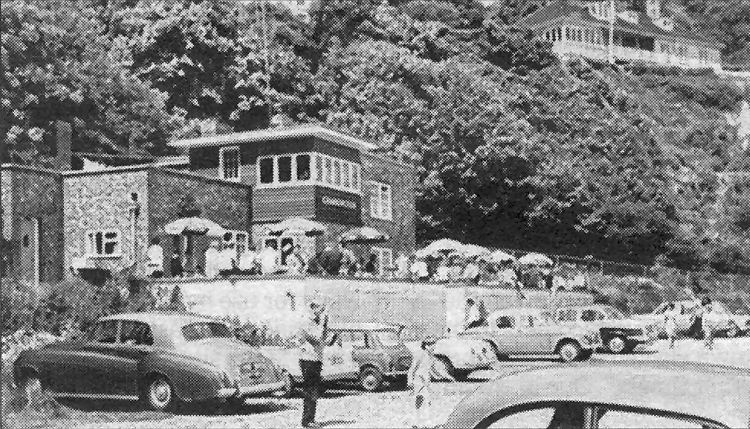
Above photo, 1950s. |
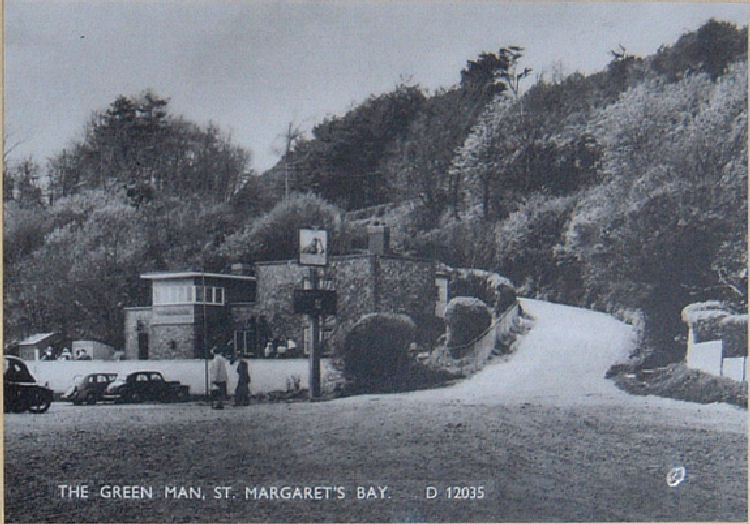 |
|
Green Man St Margaret's date unknown. After 1953. |
 |
|
Green Man St Margaret's, postmarked 1959. |
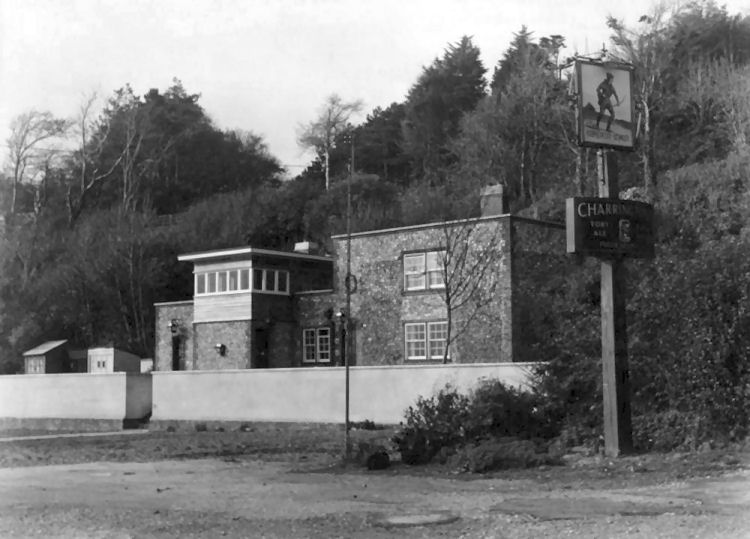
Above photo 1954.
Creative Commons Licence. |
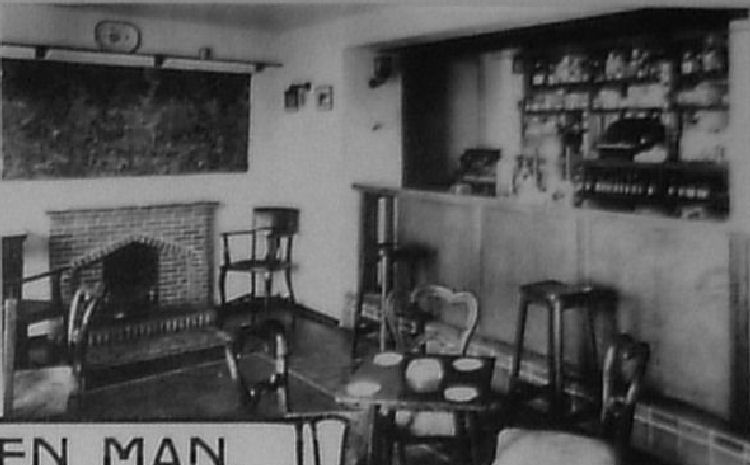 |
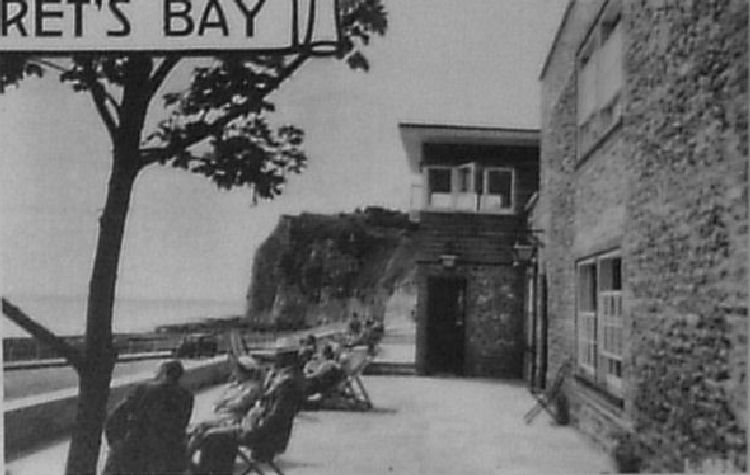 |
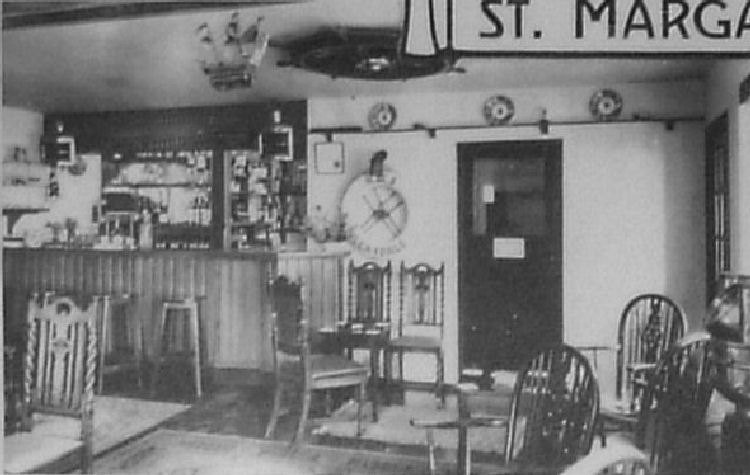 |
|
Above three pictures are of the Green Man St Margaret's. By kind
permission of the Coastguard. Date unknown. After 1953. |
|
From the Dover Express and East Kent News. 26 April, 1963.
"Green Man" Raided.
A thief forced his way through the cellar flap of the Green Man
public house in the Bay on Thursday night last week and stole £10 in
cash. He ignored the stock.
|
Still the Green Man in 1965 according to Kelly's directory of 1965, this pub
was later re-named the "Coastguard".
|
From an email received 18 July, 2013
The change of
name from "Green Man" to "Coastguard" happened in 1971 and I was 24
at the time.
The pub was closed when I took over as manager with Charringtons. At
the time a coastguard returned to St. Margaret's, so I took this
opportunity for publicity and changed the name with the help of the
coastguard and arranged helicopter etc. and that is just a little bit of
info if this is of any interest.
Mike Griggs.
|
This is the closest pub to France a mere 20 miles away being situated just off
the beach at St Margaret's Bay.
In was in the Bay that the Channel Tunnel Co began the first test boring in
1865. The bore discovered coal and the Channel tunnel project was pigeon-holed.
LICENSEE LIST
PEAKE Stephen 1740-82+

TAYLOR Henry & Mary 1841+ (age 70 & 65 in 1841)
DREW Stephen 1851-61 (age 37 in 1861 ) )

CRAMP George 1861-Apr/1900 dec'd (age 68 in 1891 ) )
         
BERRY George Henry Apr/1900-Nov/21+ (also Naval pensioner age 51 in 1911 ) )
     
WELLARD William Alfred Nov/1921-24+
 
DAVIS Mr John (Jack) 1930-Sept/37
  
GRAY Mr C W Sept/1937-Mar/1939+
  
COLSON Robert H Mar/1939-40


HAWKINS George A M 1954-June/57 

MARTIN A E June/1957-Oct/64
AUSTEN A C Oct/1964-Feb/67
BEAUMONT Feb/1967+
https://pubwiki.co.uk/GreenMan.shtml
George Berry was also captain of the St, Margaret's Fire Brigade
 From Wingham Division Ale Licences 1740 Ref: KAO - QRLV 3/1 From Wingham Division Ale Licences 1740 Ref: KAO - QRLV 3/1
 From Melville's Directory 1858 From Melville's Directory 1858
 From the Post Office Directory 1874 From the Post Office Directory 1874
 From Pikes Dover Blue Book 1889 From Pikes Dover Blue Book 1889
 From Pikes Dover Blue Book 1890 From Pikes Dover Blue Book 1890
 From Pikes Dover Blue Book 1891 From Pikes Dover Blue Book 1891
 From Pikes Dover Blue Book 1895 From Pikes Dover Blue Book 1895
 From Pikes Dover Blue Book 1896-97 From Pikes Dover Blue Book 1896-97
 From Pikes Dover Blue Book 1898 From Pikes Dover Blue Book 1898
 From Pikes Dover Blue Book 1899 From Pikes Dover Blue Book 1899
 From Pikes Dover Blue Book 1899-1900 From Pikes Dover Blue Book 1899-1900
 From the Kelly's Directory 1903 From the Kelly's Directory 1903
 From the Post Office Directory 1913 From the Post Office Directory 1913
 From the Post Office Directory 1914 From the Post Office Directory 1914
 From the Post Office Directory 1918 From the Post Office Directory 1918
 From the Post Office Directory 1922 From the Post Office Directory 1922
 From Pikes Dover Blue Book 1924 From Pikes Dover Blue Book 1924
 From the Post Office Directory 1930 From the Post Office Directory 1930
 From Pikes Dover Blue Book 1932-33 From Pikes Dover Blue Book 1932-33
 From the Post Office Directory 1938 From the Post Office Directory 1938
 From Pikes Dover Blue Book 1938-39 From Pikes Dover Blue Book 1938-39
 From the Dover Express From the Dover Express
 Census Census
|





















